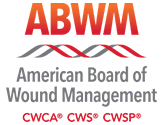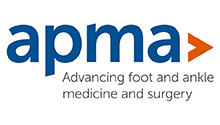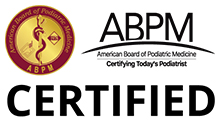Items filtered by date: March 2021
The Most Severe Kind of Ankle Sprain
 Ankle sprains occur when the foot is twisted beyond its usual range, and the ligaments that connect the bones become torn. Sprains are usually placed into three grades or categories. The first category, known as grade one, is a simple stretching or light tearing of the ligament, and there is minimal pain, swelling, or stiffness. A grade two sprain results from a partial tear of the ligament and leads to moderate swelling and bruising, as well as pain while walking. The most severe type of sprain, a grade three sprain, is a complete tear of the ligaments in the ankle. Swelling and bruising may be severe, and walking can be almost impossible. Grade three sprains may require a cast or brace, and surgery may be considered. Patients who have an ankle sprain should consult with a podiatrist who can make sure that there are no broken bones and provide treatment options.
Ankle sprains occur when the foot is twisted beyond its usual range, and the ligaments that connect the bones become torn. Sprains are usually placed into three grades or categories. The first category, known as grade one, is a simple stretching or light tearing of the ligament, and there is minimal pain, swelling, or stiffness. A grade two sprain results from a partial tear of the ligament and leads to moderate swelling and bruising, as well as pain while walking. The most severe type of sprain, a grade three sprain, is a complete tear of the ligaments in the ankle. Swelling and bruising may be severe, and walking can be almost impossible. Grade three sprains may require a cast or brace, and surgery may be considered. Patients who have an ankle sprain should consult with a podiatrist who can make sure that there are no broken bones and provide treatment options.
Ankle sprains are common but need immediate attention. If you need your feet checked, contact Barbara J. Aung, DPM from Aung Foot Health Clinic . Our doctor can provide the care you need to keep you pain-free and on your feet.
How Does an Ankle Sprain Occur?
Ankle sprains take place when the ligaments in your ankle are torn or stretched beyond their limits. There are multiple ways that the ankle can become injured, including twisting or rolling over onto your ankle, putting undue stress on it, or causing trauma to the ankle itself.
What Are the Symptoms?
- Mild to moderate bruising
- Limited mobility
- Swelling
- Discoloration of the skin (depending on severity)
Preventing a Sprain
- Wearing appropriate shoes for the occasion
- Stretching before exercises and sports
- Knowing your limits
Treatment of a Sprain
Treatment of a sprain depends on the severity. Many times, people are told to rest and remain off their feet completely, while others are given an air cast. If the sprain is very severe, surgery may be required.
If you have suffered an ankle sprain previously, you may want to consider additional support such as a brace and regular exercises to strengthen the ankle.
If you have any questions please feel free to contact our office located in Tuscon, AZ . We offer the newest diagnostic and treatment technologies for all your foot and ankle needs.
It's Time for Beautiful Feet
What Is Clubfoot?
 Clubfoot is a common deformity amongst newborn babies and occurs when the foot is twisted and pointed. The most common cause of clubfoot occurs when the Achilles tendon is too short, and this pulls the foot up. Thankfully, clubfoot is not painful for the baby, and it is easily treatable. Treatment will be necessary so the baby can learn to walk when they are a toddler. Treatment is most successful when the baby is only a week or two old, but treatment can still be successful if it is done later. While nonsurgical treatment options such as physical therapy, splinting, or casting is preferred, surgery can also be used to treat clubfoot. If your child is born with clubfoot, make sure to consult with a podiatrist as soon as possible for treatment.
Clubfoot is a common deformity amongst newborn babies and occurs when the foot is twisted and pointed. The most common cause of clubfoot occurs when the Achilles tendon is too short, and this pulls the foot up. Thankfully, clubfoot is not painful for the baby, and it is easily treatable. Treatment will be necessary so the baby can learn to walk when they are a toddler. Treatment is most successful when the baby is only a week or two old, but treatment can still be successful if it is done later. While nonsurgical treatment options such as physical therapy, splinting, or casting is preferred, surgery can also be used to treat clubfoot. If your child is born with clubfoot, make sure to consult with a podiatrist as soon as possible for treatment.
Making sure that your children maintain good foot health is very important as they grow. If you have any questions, contact Barbara J. Aung, DPM of Aung Foot Health Clinic . Our doctor can provide the care you need to keep you pain-free and on your feet.
Keeping Children's Feet Healthy
Having healthy feet during childhood can help prevent medical problems later in life, namely in the back and legs. As children grow, their feet require different types of care. Here are some things to consider...
Although babies do not walk yet, it is still very important to take care of their feet.
Avoid putting tight shoes or socks on his or her feet.
Allow the baby to stretch and kick his or her feet to feel comfortable.
As a toddler, kids are now on the move and begin to develop differently. At this age, toddlers are getting a feel for walking, so don’t be alarmed if your toddler is unsteady or ‘walks funny’.
As your child gets older, it is important to teach them how to take care of their feet.
Show them proper hygiene to prevent infections such as fungus.
Be watchful for any pain or injury.
Have all injuries checked by a doctor as soon as possible.
Comfortable, protective shoes should always be worn, especially at play.
If you have any questions please feel free to contact our office located in Tuscon, AZ . We offer the newest diagnostic and treatment technologies for all your foot and ankle needs.
Off-the-Shelf vs. Custom-Made Foot Orthotics
 When you are experiencing foot pain, any relief is welcome. Pre-made shoe inserts (foot orthotics) purchased at the drug store can alleviate discomfort for some people. There are also custom-made foot orthotics which go a step further. A podiatrist first determines the cause of your foot pain, and creates either a 3D model or takes an impression of your actual feet. Then, a customized foot orthotic is created to fit you and treat the specific nature of your pain. These made-to-order orthotics can benefit patients with conditions such as plantar fasciitis, bunions, high arches and various forms of arthritis. If you are experiencing pain in one or both of your feet, don’t suffer in silence. It is suggested that you call a podiatrist to see if foot orthotics can improve your quality of life.
When you are experiencing foot pain, any relief is welcome. Pre-made shoe inserts (foot orthotics) purchased at the drug store can alleviate discomfort for some people. There are also custom-made foot orthotics which go a step further. A podiatrist first determines the cause of your foot pain, and creates either a 3D model or takes an impression of your actual feet. Then, a customized foot orthotic is created to fit you and treat the specific nature of your pain. These made-to-order orthotics can benefit patients with conditions such as plantar fasciitis, bunions, high arches and various forms of arthritis. If you are experiencing pain in one or both of your feet, don’t suffer in silence. It is suggested that you call a podiatrist to see if foot orthotics can improve your quality of life.
If you are having discomfort in your feet and would like to try orthotics, contact Barbara J. Aung, DPM from Aung Foot Health Clinic . Our doctor can provide the care you need to keep you pain-free and on your feet.
What Are Orthotics?
Orthotics are inserts you can place into your shoes to help with a variety of foot problems such as flat feet or foot pain. Orthotics provide relief and comfort for minor foot and heel pain but can’t correct serious biomechanical problems in your feet.
Over-the-Counter Inserts
Orthotics come in a wide variety of over-the-counter inserts that are used to treat foot pain, heel pain, and minor problems. For example, arch supports can be inserted into your shoes to help correct overarched or flat feet, while gel insoles are often used because they provide comfort and relief from foot and heel pain by alleviating pressure.
Prescription Orthotics
If over-the-counter inserts don’t work for you or if you have a more severe foot concern, it is possible to have your podiatrist prescribe custom orthotics. These high-quality inserts are designed to treat problems such as abnormal motion, plantar fasciitis, and severe forms of heel pain. They can even be used to help patients suffering from diabetes by treating foot ulcers and painful calluses and are usually molded to your feet individually, which allows them to provide full support and comfort.
If you are experiencing minor to severe foot or heel pain, it’s recommended to speak with your podiatrist about the possibilities of using orthotics. A podiatrist can determine which type of orthotic is right for you and allow you to take the first steps towards being pain-free.
If you have any questions please contact our office located in Tuscon, AZ . We offer the newest diagnostic and treatment technologies for all your foot and ankle needs.
Exercising the Feet Can Be Fast and Easy
 Stretching and exercising your feet is an often overlooked step in health and fitness routines. However, keeping the feet strong and flexible is important, as this can help prevent foot and ankle pain, improve your foot health, and keep you active. Though it may seem like an added burden to have to take time to stretch your feet, it can actually be quick, easy, and fun to incorporate foot exercises into your daily routine. One simple exercise that you can do to strengthen the muscles on the top of your feet and toes is towel scrunches. Set a towel down on the floor, then sit in a chair with your feet directly on top of the towel. Using only your toes, scrunch up the towel, pulling it toward you. Do this five times with each foot. For more information about exercising your feet, please consult with a podiatrist.
Stretching and exercising your feet is an often overlooked step in health and fitness routines. However, keeping the feet strong and flexible is important, as this can help prevent foot and ankle pain, improve your foot health, and keep you active. Though it may seem like an added burden to have to take time to stretch your feet, it can actually be quick, easy, and fun to incorporate foot exercises into your daily routine. One simple exercise that you can do to strengthen the muscles on the top of your feet and toes is towel scrunches. Set a towel down on the floor, then sit in a chair with your feet directly on top of the towel. Using only your toes, scrunch up the towel, pulling it toward you. Do this five times with each foot. For more information about exercising your feet, please consult with a podiatrist.
Stretching the feet is a great way to prevent injuries. If you have any concerns with your feet consult with Barbara J. Aung, DPM from Aung Foot Health Clinic . Our doctor will assess your condition and provide you with quality foot and ankle treatment.
Stretching the Feet
Stretching the muscles in the foot is an important part in any physical activity. Feet that are tight can lead to less flexibility and make you more prone to injury. One of the most common forms of foot pain, plantar fasciitis, can be stretched out to help ease the pain. Stretching can not only ease pain from plantar fasciitis but also prevent it as well. However, it is important to see a podiatrist first if stretching is right for you. Podiatrists can also recommend other ways to stretch your feet. Once you know whether stretching is right for you, here are some excellent stretches you can do.
- Using a foam roller or any cylindrical object (a water bottle or soda can will do), roll the object under your foot back and forth. You should also exert pressure on the object. Be sure to do this to both feet for a minute. Do this exercise three times each.
- Similar to the previous one, take a ball, such as a tennis ball, and roll it under your foot while seated and exert pressure on it.
- Grab a resistance band or towel and take a seat. If you are using a towel, fold it length wise. Next put either one between the ball of your foot and heel and pull with both hands on each side towards you. Hold this for 15 seconds and then switch feet. Do this three times for each foot.
- Finally hold your big toe while crossing one leg over the other. Pull the toe towards you and hold for 15 seconds. Once again do this three times per foot.
It is best to go easy when first stretching your foot and work your way up. If your foot starts hurting, stop exercising and ice and rest the foot. It is advised to then see a podiatrist for help.
If you have any questions, please feel free to contact our office located in Tuscon, AZ . We offer the newest diagnostic and treatment technologies for all your foot care needs.
Types of Achilles Tendon Injuries
 The Achilles tendon is a thick band connecting the calf muscle to the heel bone on the back of the ankle. One common injury, Achilles tendonitis, is the result of the tendon becoming inflamed near its connection to the heel bone. This injury is often a result of overuse. Achilles tendinosis occurs when the tendon degenerates, often as a result of not treating Achilles tendonitis. One of the most severe Achilles tendon injuries is a rupture. This occurs when the fibers in the tendon are partially or completely torn. This requires immediate medical attention. Most Achilles tendon injuries result in pain in the calf and heel while moving, and a rupture will produce a sudden sharp pain in the calf and heel. If you are noticing pain or stiffness in the area of your Achilles tendon, please consult with a podiatrist as soon as possible.
The Achilles tendon is a thick band connecting the calf muscle to the heel bone on the back of the ankle. One common injury, Achilles tendonitis, is the result of the tendon becoming inflamed near its connection to the heel bone. This injury is often a result of overuse. Achilles tendinosis occurs when the tendon degenerates, often as a result of not treating Achilles tendonitis. One of the most severe Achilles tendon injuries is a rupture. This occurs when the fibers in the tendon are partially or completely torn. This requires immediate medical attention. Most Achilles tendon injuries result in pain in the calf and heel while moving, and a rupture will produce a sudden sharp pain in the calf and heel. If you are noticing pain or stiffness in the area of your Achilles tendon, please consult with a podiatrist as soon as possible.
Achilles tendon injuries need immediate attention to avoid future complications. If you have any concerns, contact Barbara J. Aung, DPM of Aung Foot Health Clinic . Our doctor can provide the care you need to keep you pain-free and on your feet.
What Is the Achilles Tendon?
The Achilles tendon is a tendon that connects the lower leg muscles and calf to the heel of the foot. It is the strongest tendon in the human body and is essential for making movement possible. Because this tendon is such an integral part of the body, any injuries to it can create immense difficulties and should immediately be presented to a doctor.
What Are the Symptoms of an Achilles Tendon Injury?
There are various types of injuries that can affect the Achilles tendon. The two most common injuries are Achilles tendinitis and ruptures of the tendon.
Achilles Tendinitis Symptoms
- Inflammation
- Dull to severe pain
- Increased blood flow to the tendon
- Thickening of the tendon
Rupture Symptoms
- Extreme pain and swelling in the foot
- Total immobility
Treatment and Prevention
Achilles tendon injuries are diagnosed by a thorough physical evaluation, which can include an MRI. Treatment involves rest, physical therapy, and in some cases, surgery. However, various preventative measures can be taken to avoid these injuries, such as:
- Thorough stretching of the tendon before and after exercise
- Strengthening exercises like calf raises, squats, leg curls, leg extensions, leg raises, lunges, and leg presses
If you have any questions please feel free to contact our office located in Tuscon, AZ . We offer the newest diagnostic tools and technology to treat your foot and ankle needs.






